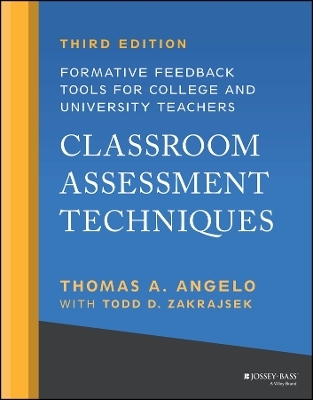
Classroom Assessment Techniques
Jossey-Bass Inc.,U.S. (Verlag)
978-1-119-86016-7 (ISBN)
A practical, research-based handbook for using assessment to improve learning.
This completely revised and updated third edition of Classroom Assessment Techniques provides a research-based, engaging guide to assessing student learning where it matters most—at course and classroom levels. Informed by the latest international educational research and 30 years of classroom assessment practice, this practical handbook is designed for postsecondary teachers from all disciplines, faculty and academic developers, and assessment professionals. It offers field-tested guidance, tools, and advice for planning, designing, and implementing formative assessment in face-to-face, hybrid, and fully online classrooms, analyzing resulting data, and using that data to improve student learning.
Classroom Assessment Techniques, 3rd Edition, is a practical, clearly written handbook for busy professionals. It contains a wealth of useful resources, including:
50-plus CATs (classroom assessment techniques) – flexible formative assessment tools easily adaptable for use in a wide range of disciplines and contexts.
Case studies and examples illustrating how college and university faculty have applied these techniques to improve learning
A new “Course Learning Outcomes Inventory” (CLOI)—a self-assessment tool for identifying and prioritizing the most relevant learning outcomes to assess
The original “Teaching Goals Inventory” (TGI) which offers an alternate, teaching-focused approach to setting assessment priorities
Multiple ways to quickly find the most appropriate tool. CATs are indexed by discipline examples, Bloom’s Taxonomy, Biggs and Tang’s SOLO Taxonomy, the CLOI, and the TGI
Brief chapters explaining what formative assessment is, how it can improve student learning, how to gather and provide formative feedback, how to link classroom assessment with broader/other assessment efforts, and how to collaborate with students and colleagues
Each CAT provides a brief, self-contained “recipe” including a description, steps for implementation, dos and don’ts, and relevant references
Thomas A. Angelo, EdD, has been a university faculty member, faculty developer, educational researcher, and academic administrator in the U.S., New Zealand, and Australia. He has consulted on curriculum design, teaching, learning, and assessment in 20 countries and in all 50 states. He is the co-author, with Dr. K. Patricia Cross, of the Second Edition of Classroom Assessment Techniques. Todd D. Zakrajsek, PhD, is an associate professor at UNC-Chapel Hill and Director of four annual Lilly Conferences on Evidence-Based Teaching and Learning. Zakrajsek has authored/co-authored six books on various topics related to effective teaching in higher education and is frequently requested to present conference keynotes and campus workshops.
Dedication to K. Patricia Cross and Richard J. Light v
Acknowledgments xi
About the Authors xiii
Preface xv
Part One: An Introduction to Classroom Assessment 1
1. What Is Classroom Assessment? 3
2. Getting and Giving Feedback for Learning 19
3. First Steps: Getting Started in Classroom Assessment 29
Part Two: Doing Classroom Assessment 39
4. Next Steps: Embedding Classroom Assessment into Courses 41
5. The Minute Paper: An Illustrative Case Study 65
6. 12 Examples of Course- Embedded Classroom Assessment 81
Part Three: Classroom Assessment Techniques 111
7. Finding and Choosing the Right Classroom Assessment Techniques 113
8. Knowledge, Recall, and Understanding 117
Plus-Minus-Question Mark 121
Background Knowledge Probe 125
Misconception/Preconception Check 130
Concept Questions 135
Focused Listing 141
Empty Outline 145
Memory Matrix 149
One-Sentence Summary 154
Minute Paper 158
Muddiest Point 163
9. Application 167
RSQC2 (Recall, Summarize, Question, Connect, and Comment) 169
Directed Paraphrasing 174
Applications Card 178
Paper or Project Prospectus 182
Performance Checklist 187
10. Problem Solving 191
Problem Recognition Tasks 193
What’s the Principle? 197
What’s Missing? or Who’s Missing? 201
Documented Problem Solution 205
Predict-Observe-Explain 209
11. Analysis and Critical Thinking 213
Categorizing Grid 215
Blooming 218
Defining Features Matrix 223
Content, Form, and Function Matrix 227
Pros-Cons-Questions 231
Analytic Memo 235
Error Analysis 239
12. Synthesis and Creative Thinking 243
Word Journal 245
Approximate Analogy 249
Student-Generated Questions 253
Concept Map 258
Invented Dialogue 263
13. Attitudes and Values 269
Opinion/Attitude Poll 271
Values Affirmation 275
Double-Entry Journal 279
Profiles of Admirable Individuals 283
Ethical Dilemma 287
14. Self- Assessment as Learners 291
Learning Interests Assessment 293
Course-Specific Mindset Assessment 297
Goal Ranking and Matching 302
Learner Autobiography 306
15. Learning and Study Skills 311
Study Strategies Assessment 313
Deliberate Practice Assessment 317
Learning and Study Time Log 321
Diagnostic Learning Log 326
Exam Wrapper 330
16. Perceptions of Learning Activities and Assessment 335
Feedback on Feedback 337
Group Work/Teamwork Assessment 341
Reading/Video Ratings 345
Assignment Feedback Form 350
Exam Feedback Form 354
17. Perceptions of Teaching and Courses 359
Teacher-Designed Feedback Form 361
Group Informal Feedback on Teaching 365
Course Feedback Team 370
Exit Ticket and Four More 374
Resources
A. Chapter Discussion Questions by Todd Zakrajsek 379
B. Alphabetical Index of CATs by Name 385
C. Index of CATs by Discipline Examples 387
D. The Course Learning Outcomes Inventory (CLOI): Self-Scorable Version 393
E. The Course Learning Outcomes Inventory (CLOI) Self-Scoring Worksheet 399
F. Index of CATs by Course Learning Outcomes Inventory (CLOI) Outcomes 403
G. Teaching Goals Inventory (TGI): Self-Scorable Version 417
H. Teaching Goals Inventory (TGI) Self-Scoring Worksheet 421
I. Index of CATs by Teaching Goals Inventory (TGI) Goals 423
J. Index of CATs by Bloom’s (2001) Revised Taxonomy of Cognitive Outcomes Levels 437
K. Index of CATs by Biggs and Collis’s SOLO Taxonomy Levels 441
L. Index of CATs by Fink’s Taxonomy of Significant Learning Categories 445
M. Minute Paper References 449
N. Acknowledgments from the 1988 and 1993 Versions 453
References 457
Author Index 465
Subject Index 473
| Erscheinungsdatum | 04.07.2024 |
|---|---|
| Verlagsort | New York |
| Sprache | englisch |
| Maße | 216 x 272 mm |
| Gewicht | 907 g |
| Themenwelt | Sozialwissenschaften ► Pädagogik ► Erwachsenenbildung |
| ISBN-10 | 1-119-86016-4 / 1119860164 |
| ISBN-13 | 978-1-119-86016-7 / 9781119860167 |
| Zustand | Neuware |
| Informationen gemäß Produktsicherheitsverordnung (GPSR) | |
| Haben Sie eine Frage zum Produkt? |
aus dem Bereich


